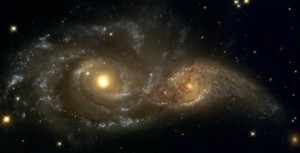
Thirteen years ago this winter, in January 1998, two teams of astronomers scientists astonished the world with their results showing that the universe would expand forever. Soon afterwards they added to the amazement by presenting evidence that the universe is not only expanding outward, it is accelerating outward! Their observations studied supernovae — the phenomenally bright deaths of massive stars — in galaxies so far away that their motions are due to the properties of the cosmos itself.
There are two explanations commonly advanced to explain the outward acceleration of the universe. The first asserts that, as Einstein once speculated, gravity itself caused objects to repel one another when they are far enough apart. This feature of gravity is called the cosmological constant, and I describe it more in Chapters 2 and 4 of Let There Be Light. The second explanation is called “dark energy.”
Dark energy is not the same thing as dark matter. Dark matter is unseen matter — unseen in the sense that it emits no detected electromagnetic radiation (light, radio waves, etc), but it has been spotted nonetheless because its gravity has measurable effects on stars and objects that we can see. As explained in Chapter 4 of the book, a mind-blowing 90% of all of the matter in the universe is dark matter. Furthermore, we do not know what dark matter is. We only know that it is almost surely of kinds of elementary particles unlike those that comprise normal atoms. Dark energy, on the other hand, is not a form of matter at all. Based on reasonable assumptions about our current understanding of elementary particle physics, scientists believe that dark energy arises from the vacuum itself, which has quantum properties that provide energy to the cosmos. It is this dark energy of the vacuum that causes the universe to expand.
Each of the two explanations for cosmic acceleration, the cosmological constant and dark energy, has its own set of ancillary implications which can be used to probe which one (or neither or both) is correct. For example, a gravitational cause would be constant in time, whereas a vacuum energy process probably is not. These differences are embodied in what physicists call the “equation of state” of dark energy, but so far the precision with which the equation of state is known allows for either explanation.
As mentioned above, the study of supernovae in distant galaxies has provided some (though not all) of the evidence for dark energy. A team of thirty-seven astronomers been working for years on a large supernova study called ESSENCE (Equation of State: Supernovae trace Cosmic Expansion). In an article that appeared this summer, 2007, the team reported its detailed analysis of sixty supernovae that went off in distant galaxies between 2002 and 2005. They find that by analyzing those supernovae, they can reduce the uncertainty in the measurement of the equation of state to about 13%; their conclusions are constrained by precision with which they know the amount of dust obscuring the light of each supernova in its host galaxy. Unfortunately, this uncertainty is still large enough to permit either explanation for the cosmic acceleration. In the next few years, however, the team expects to be able to reduce their uncertainties even further. Their results will have fundamental implications for our understanding of the laws of basic physics and the nature of our universe.
DARK ENERGY, ANGELS and ASTROLOGY: I once heard the Nobel Prize-winning physicist Prof. Charles Townes field a question about dark energy in a public forum. The questioner asked whether angels might not be considered analogous to dark energy, since they are also unseen yet have profound effects. There was an implication that perhaps dark energy was evidence for the existence of angels. Prof. Townes answered the question somewhat noncommitally, but I would offer a stronger response from a Jewish and Kabbalistic perspective.
All of creation — not just dark energy! — has its angels. As Maimonides puts it (Guide, II, 6), “all parts of the universe, even the limbs of animals in their actual form, are produced through angels, for natural forces and angels are identical.” The rabbis expressed this sentiment in many contexts, often starting from Psalm 103; 4 -14: “He makes the winds His messengers, the flames of fire His ministers…He causes the grass to grow for cattle….” All the forces of nature, explain the rabbis, are God’s ministers, and as such are manifestations of angels. The Zohar puts it plainly: “‘Who causes the grass to grow’ refers to the multitude of angels who were created on the second day of Creation (Zohar III, 217a).” The rabbis further connect these messengers/angels with the stars: “There is no blade of grass that does not have a constellation over it tell it to grow.” Every star has an angel, as indeed do each of us. Maimonides discusses at some length the role of angels, and the dubious credibility of astrological predictions: “It is the object and centre of Scripture to abolish idolatry and to overthrow the opinion that any of the stars could interfere for good or ill in human matters, because it leads to the worship of stars (op cit, III, 37).”